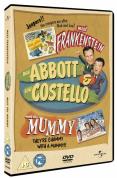 Bud Abbott And Lou Costello - Meet Frankenstein / Meet The Mummy | DVD | (28/08/2006)
from £N/A
| Saving you £N/A (N/A%)
| RRP
Bud Abbott And Lou Costello - Meet Frankenstein / Meet The Mummy | DVD | (28/08/2006)
from £N/A
| Saving you £N/A (N/A%)
| RRP Meet Frankenstein: The world of freight handlers Wilbur Grey and Chick Young is turned upside down when the remains of Frankenstein's monster and Dracula arrive from Europe to be used in a house of horrors. Dracula awakens and escapes with the weakened monster who he plans to re-energize with a new brain. Larry Talbot (the Wolfman) arrives from London in an attempt to thwart Dracula. Dracula's reluctant aide is the beautiful Dr. Sandra Mornay. Her reluctance is dispatched by Dracula's bite. Dracula and Sandra abduct Wilbur for his brain and recharge the monster in preparation for the operation. Chick and Talbot attempt to find and free Wilbur but when the full moon rises all hell breaks loose with the Wolfman Dracula and Frankenstein all running rampant. Meet The Mummy: In Egypt Peter and Freddie find the archaeologist Dr. Zoomer murdered before they can return to America. A medallion leads them to a crypt where a revived mummy provides the terror.
![Wizards [DVD]](/pictures/1140133.jpg) Wizards | DVD | (13/06/2016)
from £9.99
| Saving you £5.00 (50.05%)
| RRP
Wizards | DVD | (13/06/2016)
from £9.99
| Saving you £5.00 (50.05%)
| RRP ![The Graham Greene Collection [DVD]](/pictures/1141203.jpg) The Graham Greene Collection | DVD | (05/09/2016)
from £N/A
| Saving you £N/A (N/A%)
| RRP
The Graham Greene Collection | DVD | (05/09/2016)
from £N/A
| Saving you £N/A (N/A%)
| RRP ![Three Cases of Murder and Orson Welles Ghost Story [DVD]](/pictures/1103676.jpg) Three Cases of Murder and Orson Welles Ghost Story | DVD | (11/10/2010)
from £N/A
| Saving you £N/A (N/A%)
| RRP
Three Cases of Murder and Orson Welles Ghost Story | DVD | (11/10/2010)
from £N/A
| Saving you £N/A (N/A%)
| RRP Unseen for many years Three Cases Of Murder and Return To Glennascaul are something of a treat for lovers of British film. The main feature is an excellent portmanteau in which the viewers' imagination is challenged by the bizarre and macabre. A notable supporting cast of British actors includes John Gregson Elizabeth Sellars Andre Morell Hugh Pryse Eddie Byrne and Alan Badel.
![The Stranger [DVD]](/pictures/1135712.jpg) The Stranger | DVD | (29/04/2015)
from £12.15
| Saving you £N/A (N/A%)
| RRP
The Stranger | DVD | (29/04/2015)
from £12.15
| Saving you £N/A (N/A%)
| RRP The legendary story that hovers over Orson Welles' The Stranger is that he wanted Agnes Moorehead to star as the dogged Nazi hunter who trails a war criminal to a sleepy New England town. The part went to Edward G. Robinson, who is marvellous, but it points out how many compromises Welles made on the film in an attempt to show Hollywood he could make a film on time, on budget and on their own terms. He accomplished all three, turning out a stylish if unambitious film noir thriller, his only Hollywood film to turn a profit on its original release. Welles stars as unreformed fascist Franz Kindler, hiding as a schoolteacher in a New England prep school for boys and newly married to the headmaster's lovely if naive daughter (Loretta Young). Welles, the director, is in fine form for the opening sequences, casting a moody tension as agents shadow a twitchy low-level Nazi official skulking through South American ports and building up to dramatic crescendo as Kindler murders this little man, the lovely woods becoming a maelstrom of swirling leaves that expose the body he furiously tries to bury. The rest of the film is a well designed but conventional cat-and-mouse game featuring an eye-rolling performance by Welles and a thrilling conclusion played out in the dark clock tower that looms over the little village. --Sean Axmaker
![Waterloo [Blu-ray] [1970]](/pictures/1152345.jpg) Waterloo | Blu Ray | (05/09/2019)
from £N/A
| Saving you £N/A (N/A%)
| RRP
Waterloo | Blu Ray | (05/09/2019)
from £N/A
| Saving you £N/A (N/A%)
| RRP ![The Black Rose [DVD]](/pictures/1105266.jpg) The Black Rose | DVD | (31/01/2011)
from £N/A
| Saving you £N/A (N/A%)
| RRP
The Black Rose | DVD | (31/01/2011)
from £N/A
| Saving you £N/A (N/A%)
| RRP Tyrone Powers stars in this glossy historical adventure as a Saxon nobleman who travels to China to make his fortune. Cast out of 13th century England after a failed rebellion against his Norman oppressors Walter of Gurnie (Tyrone Power) first travels to North Africa where he encounters headstrong tribal leader Bayan (Orson Welles). As he journeys further afield he eventually reaches China where at the insistence of his hosts he remains accumulating scientific knowledge. Finally fleeing his captors Walter returns to his native land where his past sins forgotten he is hailed as a hero.
![Citizen Kane [1941]](/pictures/1013350.jpg) Citizen Kane | DVD | (20/09/1999)
from £9.99
| Saving you £10.00 (100.10%)
| RRP
Citizen Kane | DVD | (20/09/1999)
from £9.99
| Saving you £10.00 (100.10%)
| RRP Arguably the greatest of American films, Orson Welles' 1941 masterpiece, made when he was only 26, still unfurls like a dream and carries the viewer along the mysterious currents of time and memory to reach a mature (if ambiguous) conclusion: people are the sum of their contradictions and can't be known easily. Welles plays newspaper magnate Charles Foster Kane, taken from his mother as a boy and made the ward of a rich industrialist. The result is that every well-meaning or tyrannical or self-destructive move he makes for the rest of his life appears in some way to be a reaction to that deeply wounding event. Written by Welles and Herman J. Mankiewicz, and photographed by Gregg Toland, the film is the sum of Welles's awesome ambitions as an artist in Hollywood. He pushes the limits of then-available technology to create a true magic show, a visual and aural feast that almost seems to be rising up from a viewer's subconscious. As Kane, Welles even ushers in the influence of Bertolt Brechton film acting. This is truly a one-of-a-kind work, and in many ways is still the most modern of modern films this century. --Tom Keogh
![Revenge of the Blood Beast [Blu-ray] [Region A & B]](/pictures/1169210.jpg) Revenge of the Blood Beast | Unknown | (15/09/2025)
from £N/A
| Saving you £N/A (N/A%)
| RRP
Revenge of the Blood Beast | Unknown | (15/09/2025)
from £N/A
| Saving you £N/A (N/A%)
| RRP A young British couple, Philip (Ian Ogilvy, Death Becomes Her) and Veronica (Barbara Steele, Black Sunday), are honeymooning in the remote village of Vaubrac, Transylvania. After reluctantly booking into a sleazy guesthouse, the couple encounter Von Helsing (John Karlsen, Slaughter Hotel), a direct descendant of the legendary vampire-hunter, who tells them the town was placed under a curse over 200 years ago, following the brutal execution of Vardella, a grotesque figure accused of witchcraft. Dismissing his story, the couple plan to leave the next morning but a mysterious car accident is the catalyst for the return of Vardella and a murderous rampage of revenge Revenge of the Blood Beast (aka The She Beast) is the directorial debut from one of British horror's most important figures, Michael Reeves (The Sorcerers, Witchfinder General), and was written and directed when he was just 23 years old. Combining comedy and gruesome horror, Revenge of the Blood Beast is an outrageously entertaining slice of B-movie Eurohorror.BLU-RAY SPECIAL FEATURESHigh Definition digital transfer from the original camera negativeUncompressed mono PCM audioAudio commentary with Paul Maslansky, Ian Ogilvy and Barbara Steele, moderated by filmmaker David Gregory (2007)Newly filmed interview with star Ian Ogilvy (2024)Newly filmed interview with author and critic Kim Newman (2024)Archival audio interview with Barbara Steele Original trailerReversible sleeve featuring artwork based on original postersNew and improved English subtitle translation for Italian audio and English SDH for English audio
![Puppetmaster 2 [Blu-ray]](/pictures/1117388.jpg) Puppetmaster 2 | Blu Ray | (22/10/2012)
from £13.49
| Saving you £2.50 (18.53%)
| RRP
Puppetmaster 2 | Blu Ray | (22/10/2012)
from £13.49
| Saving you £2.50 (18.53%)
| RRP You can't keep a good man down or a Puppet Master buried as Tunneler, Leech Woman, Pinhead and the rest of the puppets return to exhume their beloved creator in Puppet Master II, the sequel to the hit horrorfest, Puppet Master. This time, the little devils are after the special fluid that keeps them alive, which is only found in...you guessed it...human brains. Lucky for the puppets, a new team of paranormal researchers has come to the hotel to investigate its murder-soaked past. (Don't these guys ever learn?) The puppets-led by a new member, the flamethrowing Torch-are happy to shed some light on the (brain) matter, as they tunnel, burn, strangle and hook to survive. Featuring the special effects wizardry of Academy Award nominee David Allen (Young Sherlock Holmes, Willow)..
![A Man For All Seasons [1966]](/pictures/1012949.jpg) A Man For All Seasons | DVD | (26/11/2001)
from £17.98
| Saving you £2.01 (11.18%)
| RRP
A Man For All Seasons | DVD | (26/11/2001)
from £17.98
| Saving you £2.01 (11.18%)
| RRP Robert Bolt's successful play, A Man for All Seasons, was not considered a hot commercial property by Columbia Pictures--a period piece about a moral issue without a star, without even a love story. Perhaps that's why Columbia left director Fred Zinnemann alone to make the film as long as he stuck to a relatively small budget. The results took everyone by surprise, as the talky morality play became a box-office hit and collected the top Oscars for 1966. At the play's heart is the standoff between King Henry VIII (Robert Shaw, in young lion form) and Sir Thomas More (Paul Scofield, in an Oscar-winning performance). Henry wants More's official approval of divorce, but More's strict ethical and religious code will not let him waffle. More's rectitude is a source of exasperation to Cardinal Wolsey (Orson Welles in a cameo), who chides, "If you could just see facts flat on without that horrible moral squint". Zinnemann's approach is all simplicity, and indeed the somewhat prosaic staging doesn't create a great deal of cinematic excitement. But the language is worth savouring, and the ethical politics are debated with all the calm and majesty of an absorbing chess game. --Robert Horton, Amazon.com
![The Warrior And The Sorceress [1984]](/pictures/1002384.jpg) The Warrior And The Sorceress | DVD | (05/11/2007)
from £14.14
| Saving you £-6.15 (N/A%)
| RRP
The Warrior And The Sorceress | DVD | (05/11/2007)
from £14.14
| Saving you £-6.15 (N/A%)
| RRP The mighty warrior Kain (David Carradine) crosses the barren wastelands of the planet Ura where two arch enemies Zeg (Luke Askew) and the evil degenerate Balcaz (William Marin) fight incessantly for control of the village's only well. Kain sees his opportunity and announces that his sword is for hire... but his eyes stay clearly on the beautiful captive sorceress Naja (Maria Socas) and his newly awakened purpose.
![Puppet Master 2 [1990]](/pictures/1022715.jpg) Puppet Master 2 | DVD | (29/07/2002)
from £N/A
| Saving you £N/A (N/A%)
| RRP
Puppet Master 2 | DVD | (29/07/2002)
from £N/A
| Saving you £N/A (N/A%)
| RRP Those nasty little puppets are back to wreack more havoc and take care of some unfinished business. Joined by 'Torch' the newest member of the sinister troop the puppets exhume their beloved creator 'Toulon' and gather the brain matter that keeps them alive. Yet the puppetmaster has a deadly plan of his own.
![Immortal Story [DVD]](/pictures/1135680.jpg) Immortal Story | DVD | (29/06/2015)
from £11.59
| Saving you £1.40 (12.08%)
| RRP
Immortal Story | DVD | (29/06/2015)
from £11.59
| Saving you £1.40 (12.08%)
| RRP Welles' second-to-last feature The Immortal Story is an adaptation of a book by Danish author Isak Dinesen and stars Jeanne Moreau. The year is 1860 in the Portuguese colony of Macao Mr. Clay (Welles) is an aging rich merchant who is the subject of town gossip. He likes his clerk Levinsky (Roger Coggio) to read to him to help him relax in the evenings and one night he recounts a tale about a rich man who paid a poor sailor five guineas to father a child with his beautiful young wife. Mr. Clay has no wife and no heir to his fortune and resolves to make the story true...Levinsky approaches Virginie Ducrot (Moreau) another clerk's mistress and strikes a bargain for 300 guineas. Now to find the sailor...
![The Lady from Shanghai (Dual Format Limited Edition) [Blu-ray]](/pictures/1143501.jpg) The Lady from Shanghai (Dual Format Limited Edition) | Blu Ray | (24/04/2017)
from £N/A
| Saving you £N/A (N/A%)
| RRP
The Lady from Shanghai (Dual Format Limited Edition) | Blu Ray | (24/04/2017)
from £N/A
| Saving you £N/A (N/A%)
| RRP Legend has it that Orson Welles more or less conned studio boss Harry Cohn over the phone into making The Lady from Shanghai by grabbing the title from a nearby paperback. In any case, this is one of Welles's most fascinating works, a bizarre tale of an Irish sailor (Welles) who accompanies a beautiful woman (Rita Hayworth) and her handicapped husband (Everett Sloane) on a cruise and becomes involved in a murder plot. But never mind all that (the aforementioned legend also claims that Cohn offered a reward to anyone who could explain the plot to him). The film is really a dream of Welles's driving preoccupations both on and off-screen at the time: the elusiveness of identity, the mystique of things lost, and most of all the director's faltering marriage to Hayworth. In the tradition of male filmmakers who indirectly tell the story of their love affairs with leading ladies, Welles tells his own, photographing Hayworth as a deconstructed star, an obvious cinematic creation, thus reflecting, perhaps, a never-satisfied yearning that leads us back to the mystery of Citizen Kane. --Tom Keogh
![Ferry To Hong Kong [DVD]](/pictures/1105585.jpg) Ferry To Hong Kong | DVD | (14/02/2011)
from £6.09
| Saving you £6.90 (113.30%)
| RRP
Ferry To Hong Kong | DVD | (14/02/2011)
from £6.09
| Saving you £6.90 (113.30%)
| RRP Mark Conrad (Curt jurgens) is an unwanted nomad - doomed to sail the Hong Kong ferry unable to disembark at either port of call. The ferry captain(Orson Welles) treats his unwanted passenger with disdain and contempt. Sylvia Syms plays an enchanting schoolmistress who falls in love with Conrad despite his constant rebuffs. Join this mismatched triangle as they battle with pirates and a raging typhoon on the Ferry to Hong Kong.
 Rita Hayworth - Screen Goddess Boxset | DVD | (03/10/2005)
from £N/A
| Saving you £N/A (N/A%)
| RRP
Rita Hayworth - Screen Goddess Boxset | DVD | (03/10/2005)
from £N/A
| Saving you £N/A (N/A%)
| RRP ![The Eyes of Orson Welles [DVD]](/pictures/1147021.jpg) The Eyes of Orson Welles | DVD | (17/09/2018)
from £5.99
| Saving you £N/A (N/A%)
| RRP
The Eyes of Orson Welles | DVD | (17/09/2018)
from £5.99
| Saving you £N/A (N/A%)
| RRP Granted exclusive access to hundreds of private drawings and paintings by Orson Welles, filmmaker Mark Cousins dives deep into the visual world of this legendary director and actor, to reveal a portrait of the artist as he's never been seen before - through his own eyes, sketched with his own hand, painted with his own brush. Executive produced by Michael Moore, The Eyes of Orson Welles brings vividly to life the passions, politics and power of this brilliant 20th-century showman, and explores how the genius of Welles still resonates today in the age of Trump, more than 30 years after his death.
 Orson Welles - Screen Legends | DVD | (05/06/2006)
from £N/A
| Saving you £N/A (N/A%)
| RRP
Orson Welles - Screen Legends | DVD | (05/06/2006)
from £N/A
| Saving you £N/A (N/A%)
| RRP What more is there to say about Orson Welles? One of the most talented and enigmatic artists that Hollywood has ever seen this box set gathers several films in his oeuvre for your viewing pleasure. Citizen Kane (Dir. Orson Welles 1941): In May of 1941 RKO Radio Pictures released a controversial film by a 25-year-old first-time director. That premier of Orson Welles' Citizen Kane was to have a profound and lasting effect of the art of motion pictures. It has been hai
![Tempo - Volume 1 [DVD]](/pictures/1114365.jpg) Tempo - Volume 1 | DVD | (21/01/2013)
from £9.98
| Saving you £12.00 (150.19%)
| RRP
Tempo - Volume 1 | DVD | (21/01/2013)
from £9.98
| Saving you £12.00 (150.19%)
| RRP ITV's seminal arts programme, Tempo ran for eight years through a decade which saw a creative explosion within all aspects of the performing arts. Its fluid style of presentation allowed an almost open-ended remit, enabling it to cover subjects as diverse as cinema, music, dance, photography, writing - and much more besides. At a time when television was being criticised for dumbing down, Tempo - more than any other series - showed that ITV could indeed go highbrow whilst still remaining populist - a philosophy and outlook that was to continue into the 1970s and beyond with its successors Aquarius and The South Bank Show.Unseen for decades, this two-disc set contains interviews, reportage and features on Jacques Tati, Stan Tracey, Henri Cartier-Bresson, Lee Strasberg, Tom Jones, Orson Welles, Harold Pinter, Charles Eames, Jean Luc-Godard and more.

Please wait. Loading...
This site uses cookies.
More details in our privacy policy